GE JS760SPSS Owner's Manual

<![endif]>RANGESElectric Front Control
SAFETY INFORMATION. . . . . . 3
USING THE RANGE |
|
Surface Units.. . . . . . . . . . . . . |
7 |
Cookware for Radiant Glass Cooktop. . . . . |
. 9 |
Oven Controls.. . . . . . . . . . . . . |
10 |
Special Features.. . . . . . . . . . . . 11 |
|
Sabbath Mode. . . . . . . . . . . . . |
12 |
Oven Racks. . . . . . . . . . . . . . .13 |
|
Aluminum Foil and Oven Liners. . . . . |
13 |
Cookware. . . . . . . . . . . . . . . |
13 |
Cooking Modes.. . . . . . . . . . . . |
14 |
Cooking Guide . . . . . . . . . . . . . 15 |
|
Air Fry Cooking Guide. . . . . . . . . |
16 |
CARE AND CLEANING
Cleaning the Range – Exterior. . . . . . .17 Cleaning the Range – Interior . . . . . . .18 Cleaning the Glass Cooktop.. . . . . . . 19 Oven Light . . . . . . . . . . . . . . 21 Oven Door. . . . . . . . . . . . . . . 22 Storage Drawer. . . . . . . . . . . . . . . . . . . . . . . . 22
TROUBLESHOOTING TIPS. . . 23 LIMITED WARRANTY. . . . . . . 26
ACCESSORIES. . . . . . . . . . . 27
CONSUMER SUPPORT. . . . . . 28
Write the model and serial numbers here:
Model #_________________
Serial #__________________
You can find them on a label behind the door or drawer.
OWNER’S MANUAL
JS645 - 30" Front Control Range
JS760 - 30" Front Control Range
ESPAÑOL
Para consultar una version en español de este manual de instrucciones, visite nuestro sitio de internet GEAppliances.com.
GE is a trademark of the General Electric Company. Manufactured under trademark license.
49-2000831 Rev. 0 08-20 GEA

THANK YOU FOR MAKING GE APPLIANCES A PART OF YOUR HOME.
Whether you grew up with GE Appliances, or this is your first, we’re happy to have you in the family.
We take pride in the craftsmanship, innovation and design that goes into every GE Appliances product, and we think you will too. Among other things, registration of your appliance ensures that we can deliver important product information and warranty details when you need them.
Register your GE appliance now online. Helpful websites and phone numbers are available in the
Consumer Support section of this Owner’s Manual. You may also mail in the pre-printed registration card included in the packing material.
2 |
|
49-2000831 Rev. 0 |
|
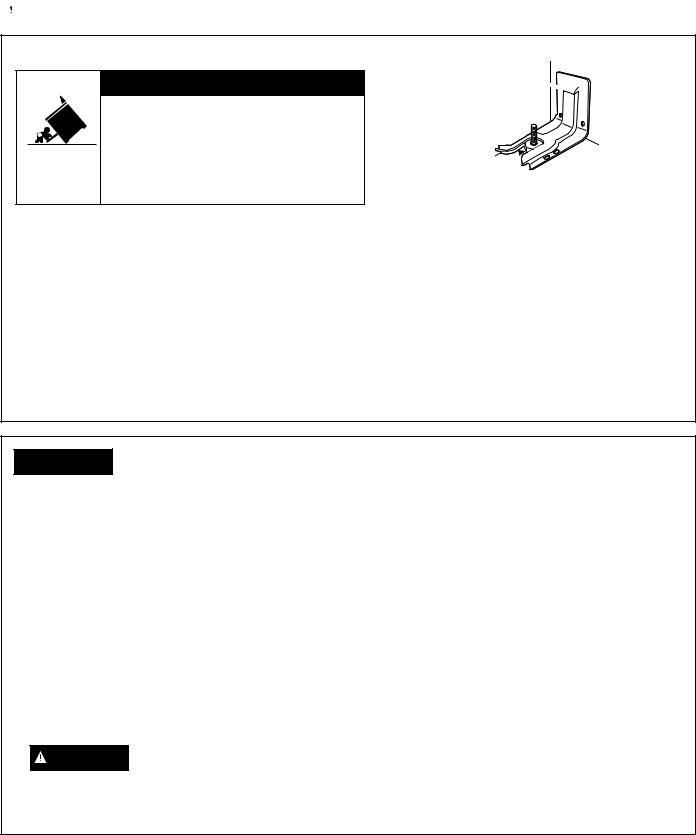
IMPORTANT SAFETY INFORMATION
READ ALL INSTRUCTIONS BEFORE USING THE APPLIANCE
|
Read all safety instructions before using the product. Failure to follow these instructions may result |
WARNING |
|
|
in fire, electrical shock, serious injury or death. |
|
ANTI-TIP DEVICE
 WARNING
WARNING
Tip-Over Hazard
• A child or adult can tip the range and be killed.
• Install the anti-tip bracket to the wall or floor.
•Engage the range to the anti-tip bracket by sliding the range back such that the foot is engaged.
•Re-engage the anti-tip bracket if the range is moved.
•Failure to do so can result in death or serious burns to children or adults.
Anti-Tip
Bracket 

Leveling Leg 
Free-Standing and Slide-In Ranges
To reduce the risk of tipping the range, the range must be secured by a properly installed anti-tip bracket. See installation instructions shipped with the bracket for complete details before attempting to install.
For Free-Standing and Slide-In Ranges
To check if the bracket is installed and engaged properly, look underneath the range to see that the rear leveling leg is engaged in the bracket. On some models, the storage drawer or kick panel can be removed for easy inspection. If visual inspection is not possible, slide the range forward, confirm the anti-tip bracket is securely attached to the floor or wall, and
slide the range back so the rear leveling leg is under the anti-tip bracket.
If your range is removed for cleaning, servicing or any reason, be sure the anti-tip device is reengaged properly when the range is replaced. Failure to take this precaution could result in tipping of the range and can result in death or serious burns to children or adults.
Never completely remove the leveling legs or the range will not be secured to the anti-tip device properly.

 WARNING GENERAL SAFETY INSTRUCTIONS
WARNING GENERAL SAFETY INSTRUCTIONS
■ |
Use this appliance only for its intended purpose as |
■ |
Use only dry pot holders—moist or damp pot |
|
|
described in this Owner’s Manual. |
|
holders on hot surfaces may result in burns from |
|
■ |
Be sure your appliance is properly installed and |
|
steam. Do not let pot holders touch hot surface |
|
|
units or heating elements. Do not use a towel or |
|||
|
grounded by a qualified installer in accordance with |
|
||
|
|
other bulky cloth in place of pot holders. |
||
|
the provided installation instructions. |
|
||
|
■ |
Never use your appliance for warming or heating |
||
■ |
Do not attempt to repair or replace any part of your |
|||
|
range unless it is specifically recommended in this |
|
the room. |
|
|
manual. All other servicing should be transferred to |
■ |
Do not touch the surface units, the heating elements |
|
|
a qualified technician. |
|
or the interior surface of the oven. These surfaces |
|
■ |
Before performing any service, unplug the range |
|
may be hot enough to burn even though they are |
|
|
dark in color. During and after use, do not touch, |
|||
|
or disconnect the power supply at the household |
|
||
|
|
or let clothing or other flammable materials contact |
||
|
distribution panel by removing the fuse or switching |
|
||
|
|
the surface units, areas nearby the surface units or |
||
|
off the circuit breaker. |
|
||
|
|
any interior area of the oven; allow sufficient time |
||
■ |
Do not leave children alone—children should not |
|
||
|
for cooling first. Other surfaces of the appliance |
|||
|
be left alone or unattended in an area where an |
|
may become hot enough to cause burns. Potentially |
|
|
appliance is in use. They should never be allowed |
|
hot surfaces include the cooktop, areas facing the |
|
|
to climb, sit or stand on any part of the appliance. |
|
cooktop, oven vent opening, surfaces near the |
|
|
|
|||
■ |
CAUTION |
Do not store items of interest to |
|
opening and crevices around the oven door. |
|
children above a range or on the backguard of a |
■ |
Do not heat unopened food containers. Pressure |
|
|
range—children climbing on the range to reach |
|
could build up and the container could burst, |
|
|
items could be seriously injured. |
|
causing an injury. |
|
READ AND SAVE THESE INSTRUCTIONS
<![endif]>INFORMATION SAFETY
49-2000831 Rev. 0 |
3 |
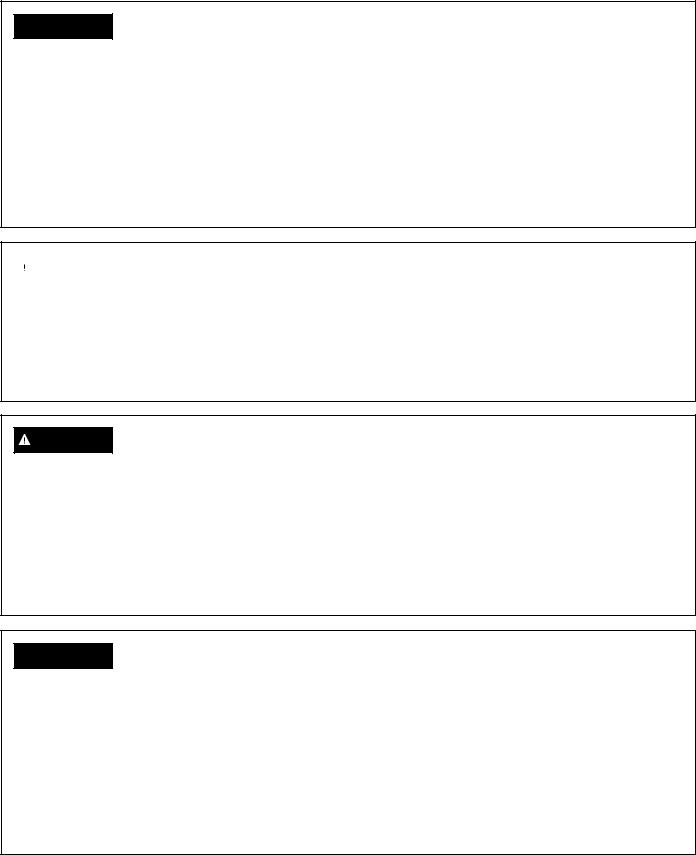
<![endif]>SAFETY INFORMATION
IMPORTANT SAFETY INFORMATION
READ ALL INSTRUCTIONS BEFORE USING THE APPLIANCE

 WARNING GENERAL SAFETY INSTRUCTIONS (Cont.)
WARNING GENERAL SAFETY INSTRUCTIONS (Cont.)
■Do not use any type of foil or liner to cover the oven bottom or anywhere in the oven, except as described in this manual. Oven liners can trap heat or melt, resulting in damage to the product and risk of shock, smoke or fire.
■Avoid scratching or impacting glass doors, cook tops or control panels. Doing so may lead to glass breakage. Do not cook on a product with broken glass. Shock, fire or cuts may occur. Contact a qualified technician immediately
■Cook food thoroughly to help protect against foodborne illness. Minimum safe food temperature recommendations can be found at IsItDoneYet.gov and fsis.usda.gov. Use a food thermometer to take food temperatures and check several locations.
|
KEEP FLAMMABLE MATERIALS AWAY FROM THE OVEN |
WARNING |
|
|
Failure to do so may result in fire or personal injury. |
|
■ |
Do not store or use flammable materials in an oven |
using the appliance. These garments may ignite if |
|
or near the cooktop, including paper, plastic, pot |
they contact hot surfaces causing severe burns. |
|
holders, linens, wall coverings, curtains, drapes and |
■ Do not let cooking grease or other flammable |
|
gasoline or other flammable vapors and liquids. |
materials accumulate in or near the range. Grease |
|
|
|
■ |
Never wear loose-fitting or hanging garments while |
in the oven or on the cooktop may ignite. |
WARNING IN THE EVENT OF A FIRE, TAKE THE FOLLOWING STEPS TO PREVENT INJURY AND FIRE SPREADING
■Do not use water on grease fires. Never pick up a flaming pan. Turn the controls off. Smother a flaming pan on a surface unit by covering the pan
completely with a well-fitting lid, cookie sheet or flat tray. Use a multi-purpose dry chemical or foam-type fire extinguisher.
■If there is a fire in the oven during baking, smother the fire by closing the oven door and turning the
oven off or by using a multi-purpose dry chemical or foam-type fire extinguisher.
■If there is a fire in the oven during self-clean, turn the oven off and wait for the fire to go out. Do not force the door open. Introduction of fresh air at selfclean temperatures may lead to a burst of flame from the oven. Failure to follow this instruction may result in severe burns.

 WARNING COOKTOP SAFETY INSTRUCTIONS
WARNING COOKTOP SAFETY INSTRUCTIONS
■Never leave the surface units unattended at medium or high heat settings. Boilovers cause smoking and greasy spillovers that may ignite.
■Never leave oil unattended while frying. If allowed to heat beyond its smoking point, oil may ignite resulting in fire that may spread to surrounding cabinets. Use a deep fat frying thermometer whenever possible to monitor oil temperature.
■To avoid oil spillover and fire, use a minimum amount of oil when shallow pan-frying and avoid cooking frozen foods with excessive amounts of ice.
■Use proper pan size—select cookware having flat bottoms large enough to cover the surface heating element. The use of undersized cookware will expose a portion of the surface unit to direct
contact and may result in ignition of clothing. Proper relationship of cookware to surface unit will also improve efficiency.
READ AND SAVE THESE INSTRUCTIONS
4 |
49-2000831 Rev. 0 |

IMPORTANT SAFETY INFORMATION
READ ALL INSTRUCTIONS BEFORE USING THE APPLIANCE

 WARNING COOKTOP SAFETY INSTRUCTIONS (Cont.)
WARNING COOKTOP SAFETY INSTRUCTIONS (Cont.)
■When using glass/ceramic cookware, make sure it is suitable for cooktop service; others may break because of sudden change in temperature.
■To minimize the possibility of burns, ignition of flammable materials and spillage, the handle of a container should be turned toward the center of the range without extending over nearby surface units.
■When preparing flaming foods under a hood, turn the fan on.
■If power is lost to an electric cooktop while a surface unit is ON, the surface unit will turn back on as soon as power is restored. In the event of power loss, failure to turn all surface unit knobs to the OFF position may result in ignition of items on or near the cooktop, leading to serious injury or death.

 WARNING RADIANT COOKTOP SAFETY INSTRUCTIONS
WARNING RADIANT COOKTOP SAFETY INSTRUCTIONS
■Use care when touching the cooktop. The glass surface of the cooktop will retain heat after the controls have been turned off.
■Do not cook on a broken cooktop. If glass cooktop should break, cleaning solutions and spillovers may penetrate the broken cooktop and create a risk of electric shock. Contact a qualified technician immediately.
■Avoid scratching the glass cooktop. The cooktop can be scratched with items such as knives, sharp instruments, rings or other jewelry, and rivets on clothing.
■Do not place or store items that can melt or catch fire on the glass cooktop, even when it is not being
used. If the cooktop is inadvertently turned on, they may ignite. Heat from the cooktop or oven vent after it is turned off may cause them to ignite also.
■Use a ceramic cooktop cleaner and non-scratch cleaning pad to clean the cooktop. Wait until the cooktop cools and the indicator light goes out before cleaning. A wet sponge or cloth on a hot surface can cause steam burns. Some cleaners can produce noxious fumes if applied to a hot surface. NOTE: Sugar spills are an exception. They should be scraped off while still hot using an oven mitt
and a scraper. See the Cleaning the glass cooktop section for detailed instructions.
■Read and follow all instructions and warnings on the cleaning cream label.

 WARNING OVEN SAFETY INSTRUCTIONS
WARNING OVEN SAFETY INSTRUCTIONS
■Stand away from the range when opening the oven door. Hot air or steam which escapes can cause burns to hands, face and/or eyes.
■Do not use the oven if a heating element develops a glowing spot during use or shows other signs
of damage. A glowing spot indicates the heating element may fail and present a potential burn, fire, or shock hazard. Turn the oven off immediately and have the heating element replaced by a qualified service technician.
■Keep the oven vent unobstructed.
■Keep the oven free from grease buildup. Grease in the oven may ignite.
■Place oven racks in desired location while oven is cool. If rack must be moved while oven is hot, do not let pot holder contact hot heating element in oven.
■When using cooking or roasting bags in the oven, follow the manufacturer’s directions.
■Pull the oven rack to the stop-lock position when loading and unloading food from the oven. This helps prevent burns from touching hot surfaces of the door and oven walls.
■Do not leave items such as paper, cooking utensils or food in the oven when not in use. Items stored in an oven can ignite.
■Never place cooking utensils, pizza or baking stones, or any type of foil or liner on the oven floor. These items can trap heat or melt, resulting in damage to the product and risk of shock, smoke or fire.
READ AND SAVE THESE INSTRUCTIONS
<![endif]>INFORMATION SAFETY
49-2000831 Rev. 0 |
5 |
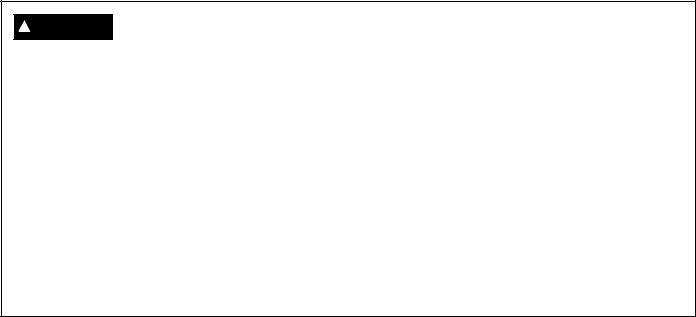
<![endif]>SAFETY INFORMATION
IMPORTANT SAFETY INFORMATION
READ ALL INSTRUCTIONS BEFORE USING THE APPLIANCE

 WARNING SELF-CLEANING OVEN SAFETY INSTRUCTIONS
WARNING SELF-CLEANING OVEN SAFETY INSTRUCTIONS
The self-cleaning feature operates the oven at temperatures high enough to burn away food soils in the oven. Follow these instructions for safe operation.
■Do not touch oven surfaces during self-clean operation. Keep children away from the oven during self-cleaning. Failure to follow these instructions may cause burns.
■Before operating the self-clean cycle, remove pans, shiny metal oven racks and other utensils from the oven. Only enameled (not shiny) oven racks may be left in the oven. Do not use self-clean to clean other parts, such as drip pans or bowls.
■Before operating the self-clean cycle, wipe grease and food soils from the oven. Excessive amount of grease may ignite leading to smoke damage to your home.
■If the self-cleaning mode malfunctions, turn the oven off and disconnect the power supply. Have it serviced by a qualified technician.
■Do not clean the door gasket. The door gasket is essential for a good seal. Care should be taken not to rub, damage or move the gasket.
■Do not use oven cleaners. No commercial oven cleaner or oven liner protective coating of any kind should be used in or around any part of the oven.
How to Remove Protective Shipping Film and Packaging Tape
Carefully grasp a corner of the protective shipping film with your fingers and slowly peel it from the appliance surface. Do not use any sharp items to remove the film.
Remove all of the film before using the appliance for the first time.
To assure no damage is done to the finish of the product, the safest way to remove the adhesive from packaging tape on new appliances is an application of a household liquid dishwashing detergent. Apply with a soft cloth and allow to soak.
NOTE: All protective packing must be removed from all parts. It cannot be removed if it is baked on.
READ AND SAVE THESE INSTRUCTIONS
6 |
49-2000831 Rev. 0 |

Surface Units
WARNING FIRE HAZARD: Never leave the range unattended with the cooktop on medium or high settings.
Keep flammable items away from the cooktop. Turn off all controls when done cooking. Failure to follow these instructions can result in fire, serious injury or death.
Throughout this manual, features and appearance may vary from your model.
NOTE: Before using the cooktop for the first time, clean it with ceramic cooktop cleaner. This helps protect the top and makes cleanup easier.
How to Set
Push the knob in and turn in either direction to the setting you want.
A surface ON indicator light will glow when any surface unit is on
For glass cooktop surfaces:
A HOT COOKTOP indicator light will:
■come on when the unit is hot to the touch.
■stay on even after the unit is turned off.
■stay on until the unit is cooled to approximately 150°F.
At both OFF and HI the control clicks |
Melt setting (on some models) |
into position. You may hear slight |
will melt chocolate or butter. |
clicking sounds during cooking, |
|
indicating the control is maintaining |
|
your desired setting. |
|
Be sure you turn the control knob to |
|
OFF when you finish cooking. |
|
Dual Surface Units and Control Knobs (on some models)
The surface unit has 2 cooking sizes to select from so you can match the size of the unit to the size of the cookware you are using.
Models with a Dual-Ring surface element only
Using the Warming Zone (on some models)

 WARNING
WARNING
FOOD POISON HAZARD: Bacteria may grow in food at temperatures below 140°F.
■Always start with hot food. Do not use warm setting to heat cold food.
■Do not use warm setting for more than 2 hours.
For models with knob, turn the control knob to On position.
For models with touch pads, press the Warming Drawer or Warming Zone pad. Use the number pad to select the temperature setting. Press 1 for Low, 2 for Medium or 3 for High, then press Start.
NOTE : The Cancel/Off pad does not turn off the Warming Drawer or Warming Zone.
NOTE : The surface warmer will NOT glow red like the cooking elements.
<![endif]>SurfaceRANGE:Units THE USING
49-2000831 Rev. 0 |
7 |
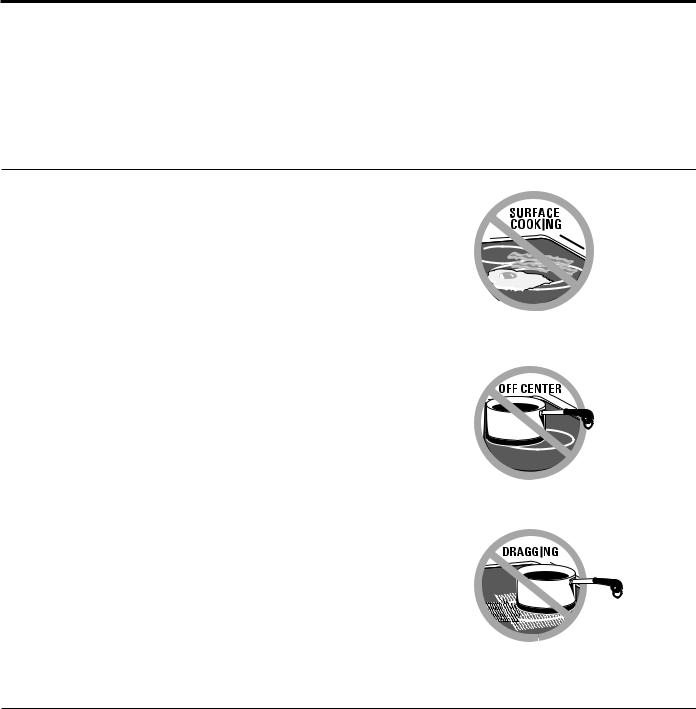
<![endif]>USING THE RANGE: Surface Units
Surface Units (Cont.)
Home Canning Tips
Be sure the canner is centered over the surface unit. Make sure the canner is flat on the bottom.
To prevent burns from steam or heat, use caution when canning.
Use recipes and procedures from reputable sources.
These are available from manufacturers such as Ball® and Kerr® and the Department of Agriculture Extension
Service.
Flat-bottomed canners are recommended. Use of water bath canners with rippled bottoms may extend the time required to bring the water to a boil.
Radiant Glass Cooktop
The radiant cooktop features heating units beneath a smooth glass surface.
NOTE: A slight odor is normal when a new cooktop is used for the first time. It is caused by the heating of new parts and insulating materials and will disappear in a short time.
NOTE: On models with light-colored glass cooktops, it is normal for the cooking zones to change color when hot or cooling down. This is temporary and will disappear as the glass cools to room temperature.
The surface unit will cycle on and off to maintain your selected control setting.
It is safe to place hot cookware on the glass surface even when the cooktop is cool.
Even after the surface units are turned off, the glass cooktop retains enough heat to continue cooking. To avoid overcooking, remove pans from the surface units when the food is cooked. Avoid placing anything on the surface unit until it has cooled completely.
■Water stains (mineral deposits) are removable using the cleaning cream or full-strength white vinegar.
■Use of window cleaner may leave an iridescent film on the cooktop. The cleaning cream will remove this film.
■Don’t store heavy items above the cooktop. If they drop onto the cooktop, they can cause damage.
■Do not use the surface as a cutting board.
Never cook directly on the glass. Always use cookware.
Always place the pan in the center of the surface unit you are cooking on.
Do not slide cookware across the cooktop because it can scratch the glass—the glass is scratchresistant, not scratch proof.
Temperature Limiter on Radiant Glass Cooktops
Every radiant surface unit has a temperature limiter.
The temperature limiter protects the glass cooktop from getting too hot.
The temperature limiter may cycle the surface units off for a time if:
■the pan boils dry.
■the pan bottom is not flat.
■the pan is off-center.
■there is no pan on the unit.
8 |
49-2000831 Rev. 0 |
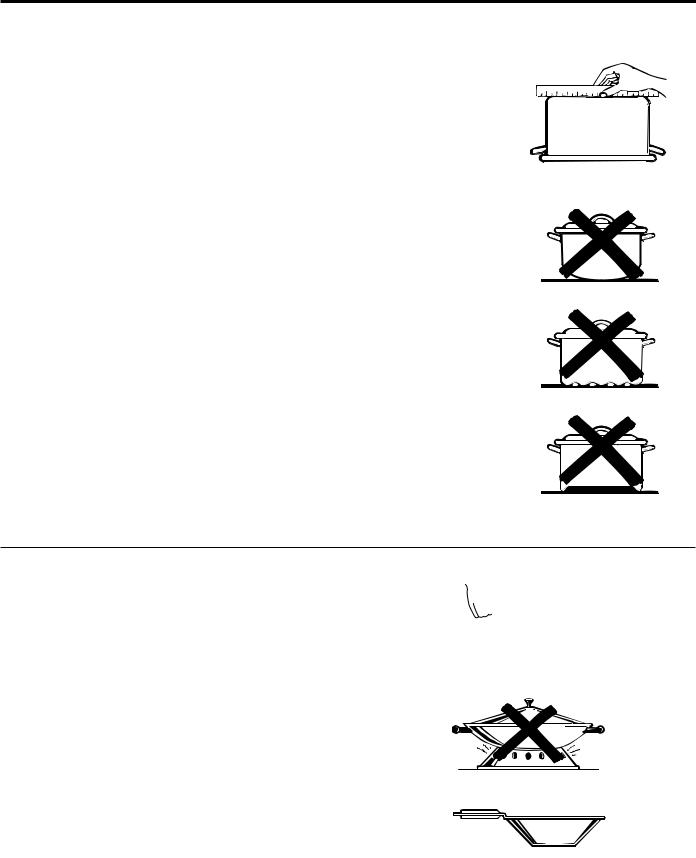
Cookware for Radiant Glass Cooktop
The following information will help you choose cookware which will give good performance on glass cooktops.
NOTE: Follow all cookware manufacturer’s recommendations when using any type of cookware on the ceramic cooktop.
Recommended
Stainless Steel
Aluminum:
heavy weight recommended
Good conductivity. Aluminum residues sometimes appear as scratches on the cooktop but can be removed if cleaned immediately. Because of its low melting point, thin weight aluminum should not be used.
Copper Bottom:
Copper may leave residues which can appear as scratches. The residues can be removed, as long as the cooktop
is cleaned immediately. However, do not let these pots boil dry. Overheated metal can bond to glass cooktops. An overheated copper bottom pot will leave a residue that will permanently stain the cooktop if not removed immediately.
Enamel (painted) on Cast Iron:
recommended if bottom of pan is coated
Avoid/Not Recommended
Enamel (painted) on Steel:
Heating empty pans can cause permanent damage to cooktop glass. The enamel can melt and bond to the ceramic cooktop.
Glass-ceramic:
Poor performance. Will scratch the surface.
Stoneware:
Poor performance. May scratch the surface.
Cast Iron:
not recommended—unless designed specifically for glass cooktops
Poor conductivity and slow to absorb heat. Will scratch the cooktop surface.
Check pans for flat bottoms by using a straight edge.
Pans with rounded, curved, ridged or warped bottoms are not recommended.
For Best Results
■Place only dry pans on the surface elements. Do not place lids on the surface elements, particularly wet lids. Wet pans and lids may stick to the surface when cool.
■Do not use woks that have support rings. This type of wok will not heat on glass surface elements.
■We recommend that you use only a flat-bottomed wok. They are available at your local retail store. The bottom of the wok should have the same diameter as the surface element to ensure proper contact.
■Some special cooking procedures require specific cookware such as pressure cookers or deep-fat fryers. All cookware must have flat bottoms and be the correct size.
Do not place wet pans on the glass cooktop.
Do not use woks with support rings on the glass cooktop.
Use flat-bottomed woks on the glass cooktop.
<![endif]>Cooktop Glass Radiant for Cookware RANGE: THE USING
49-2000831 Rev. 0 |
9 |
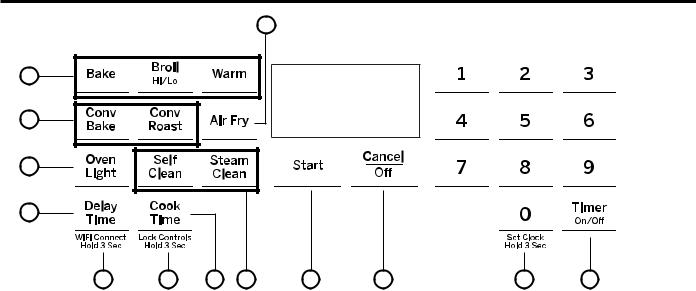
<![endif]>USING THE RANGE: Oven Controls
Oven Controls
13
2
1
10
9
12 |
11 |
6 |
3 |
4 |
1. Convection Cooking Modes (on some
models): Convection cooking modes use increased air circulation to improve performance. The type of benefit depends on the mode. Your oven has the following convection cooking modes: Convection Bake and Convection Roast. See the Cooking Modes section for more information.
2. Traditional Cooking Modes: Your oven has
the following traditional cooking modes: Bake, Broil Hi/Lo, and Warm. See the Cooking Modes section for more information.
3. Clean: Your oven has two cleaning modes: Self Clean and Steam Clean. See the Cleaning the Oven section for important information about using these modes.
4. Start: Must be pressed to start any cooking, cleaning, or timed function.
5. Cancel/Off: Cancels ALL oven operations except the clock, timer, Warming Drawer and Warming Zone.
6. Cook Time: Counts down cooking time and turns off the oven when the cooking time is complete. Press the Cook Time pad, use the number pads to program a cooking time in hours and minutes, then press Start. This can only be used with Bake, Convection Bake, Convection Roast, Warm, and Air Fry.
You may use Cook Time at any point during the oven cooking cycle
7. Clock: Press and hold the 0 pad for 3 seconds to set clock.
8. Timer On/Off: Works as a countdown timer. Press the Timer On/Off pad and the number pads to program the time in hours and minutes. Press the Start pad. The timer countdown is complete. To turn the timer off press the Timer On/Off pad.
5 |
7 |
8 |
9. Delay Time: Delays when the oven will turn on. Use this to set a time when you want the oven to start. Press the Delay Time pad and use the number pads to program the time of day for the oven to turn on then press Start. Press the desired cooking mode and temperature then press Start. A Cook Time may also be programmed if desired. Follow the directions under Cook Time for setting this feature. This can only be used with Bake, Convection Bake, Convection Roast, and Self-Clean.
NOTE: When using the Delay Time feature, foods that spoil easily—such as milk, eggs, fish, stuffings, poultry and pork—should not be allowed to sit for more than
1 hour before or after cooking. Room temperature promotes the growth of harmful bacteria. Be sure that the oven light is off because heat from the bulb will speed harmful bacteria growth.
10.Oven Light: Turns the oven light on or off.
11.Lock Controls: Locks out the control so that
pressing the pads does not activate the controls. Press the Lock Controls pad, for three seconds to lock or unlock the control. Cancel/Off is always active, even when the control is locked.
12. WiFi Connect (on some models): For
instructions on how to connect your oven, see the WiFi Connect section of this manual.
13. Air Fry (on some models): The Air Fry mode is designed to produce foods with a crispier exterior than traditional oven cooking. See the Oven Cooking Modes section for more information.
10 |
49-2000831 Rev. 0 |
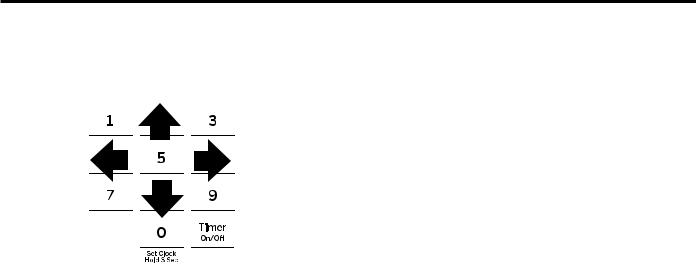
Special Features
There are several different special features on your range. To change the settings of these special features:
■Press the Bake and Broil pads at the same time and hold until the special features menu is displayed.
■Use the 2 or 8 number pads to scroll through the special features until the desired feature is displayed.
■Press the 6 number pad to enter into the feature’s menu and scroll through the options.
■Once the desired option is displayed, press the 6 pad to save the setting and the 4 pad to exit the menu.
options until the desired setting is displayed. Press 6 to save the setting and then 4 to exit the menu.
4 = Cancel/Back, 2 = Up, 8 = Down, 6 = Save/Forward
Adjust the Oven Temperature (OFSt)
This feature allows the oven baking temperature to be adjusted up to 35ºF hotter or down to 35ºF cooler. Use this feature if you believe your oven temperature is too hot or too cold and wish to change it. This adjustment affects every cooking mode except broil.
Enter into the special features menu as outlined above. Scroll through the features until “OFSt” is displayed and press 6. Use the 2 pad to increase the adjusted temperature or use the 8 pad to decrease the adjusted temperature. Save and exit the special features menu.
End of Timer Signals (End tonE)
This is the tone that signals the end of a timer. The tone can be either continuous (Cont) or single (bEEp). The continuous setting (Cont) will repeatedly sound a tone every few seconds until a button on the control is pressed. A single setting (bEEp) will sound just a
single tone at the end of the timer. Enter into the special features menu as outlined above. Scroll through the options until “End tonE” is displayed and press 6. Scroll through the options until the desired setting is displayed. Press 6 to save the setting and then 4 to exit the menu.
Fahrenheit or Celsius Temperature Display (Unit dEg)
The oven control is set to use Fahrenheit temperatures (F), but you can change it to use Celsius temperatures
(C). Enter into the special features menu as outlined above. Scroll through the options until “deg Unit” is displayed and press 6. Scroll through the options until the desired setting is displayed. Press 6 to save the setting and then 4 to exit the menu.
Clock Display (CLoc diSP)
This feature (On/Off) specifies if the time of day is displayed. Enter into the special features menu as outlined above. Scroll through the options until “Cloc diSP” is displayed and press 6. Scroll through the
Clock Configuration (Cloc cFg)
This feature specifies how the time of day will be displayed. You can select a standard 12-hour clock (12) or 24-hour military time display. Enter into the special features menu as outlined above. Scroll through the options until “Cloc cFg” is displayed and press 6. Scroll through the options until the desired setting is displayed. Press 6 to save the setting and then 4 to exit the menu.
Sound Volume (Snd)
This feature allows the oven tone volume to be adjusted on and off (oFF). Enter into the special features menu as outlined above. Scroll through the options until “sound” is displayed and press 6. Scroll through the options until the desired setting is displayed. Press 6 to save the setting and then 4 to exit the menu. The selected sound option will play once 6 is pressed.
Auto Recipe Conversion
This feature (On/Off), automatically adjusts the programmed recipe temperature in Convection MultiBake mode. Enter into the special features menu as outlined above. Scroll through the options until “Auto rEciPE” is displayed. Scroll through the options until the desired setting is displayed. Press 6 to save the setting and then 4 to exit the menu.
NOTE: This option does not convert baking time, only temperatures. This option does not adjust temperatures for Convection Roast mode.
Remote Enable (App ENbl) (on some models)
Allows you to control your oven remotely (On/Off). Enter the special features menu as outlined above. Scroll through the options until "App ENbl" is displayed. Use 6 to enter the menu and toggle the setting using the 2 or 8 key. Press the 6 key to save the setting and then 4 to exit the menu.
12-Hour Auto Shut Off (12H Shut)
This feature turns off the oven after 12 hours of continuous operation (On/Off). Enter the special features menu as outlined above. Scroll through the options until
"12H Shut" is displayed. Use 6 to enter the menu and toggle the setting using the 2 or 8 key. Press the 6 key to save the setting and then 4 to exit the menu.
<![endif]>Features Special RANGE: THE USING
49-2000831 Rev. 0 |
11 |

<![endif]>USING THE RANGE: Sabbath Mode
Sabbath Mode
The Sabbath mode feature complies with standards set forth by Star K. Some of these standards that will be noticed by the consumer include the disabling of tones, disabling of oven lights, and delays of about 30 seconds to one minute on display changes. Only continuous baking or timed baking is allowed in the Sabbath mode. Cooking in the Sabbath mode is a two-step process, first the Sabbath mode must be set and then the bake mode must be set.
Setting the Sabbath Mode
1.Press and hold Bake + Broil to enter special features menu.
2.Use number key 8 to navigate to “Sabb” menu, Enter the menu using number key 6.
3.Use number key 8 again to toggle the setting to ON. Use number key 6 to confirm the setting.
4.Use number key 4 to exit Special features menu.
Starting a Continuous Bake
1.Press the Bake pad.
2.If the desired temperature is 350F, press Start. If a different cooking temperature is desired, use the 1 through 5 number pads or Timer pad to select a
preset cooking temperature, then press Start. Refer to the graphic below to determine which pad sets the desired cooking temperature.
After a delay, a second bracket “] [“ will appear in the display indicating that the oven is baking.
|
|
|
Temperature (°F) |
|
400 |
|
|
|||||||
|
|
|
|
|
|
|
|
|
|
|
|
|
|
|
170 |
200 |
250 |
300 |
|
325 |
|
|
|
|
|
|
|
||
|
|
|
|
|
|
|||||||||
|
|
|
|
|
|
|
|
|
|
|
|
|
|
|
|
|
|
|
|
|
|
|
|
|
|
|
|
|
|
2h |
2.5h |
3h |
3.5h |
4h |
|
|
|
|
|
|
|
|||
|
|
|
|
|
|
|||||||||
|
|
|
|
|
|
|
|
|
|
|
|
|
|
|
|
|
|
|
|
|
|
|
|
|
|
|
|
|
|
|
|
|
|
Time (hours) |
|
|
|
|||||||
|
|
|
|
|
|
|
|
|
6h |
|||||
1 = 170° F, 2 = 200° F, 3 = 250° F, 4 = 300° F, 5 = 325° F, Timer = 400° F
6 = 2 hours, 7 = 2.5 hours, 8 = 3 hours, 9 = 3.5 hours,
0 = 4 hours, Lock Controls = 6 hours
Adjusting the Temperature
1.Press Bake, use the 1 through 5 number pads and the Timer pad to select a different preset cooking temperature, and press Start.
2.Since no feedback is given during temperature change, an oven thermometer can be used to confirm temperature changes.
Starting a Timed Bake
1.Press the Bake pad.
2.If the desired temperature is 350F, use the 6 through 0 number pads or the Lock Control pad to select
a cooking time. If a cooking temperature other than 350F is desired, use the 1 through 5 number pads or the Timer pad to select a preset cooking temperature, then select the cooking time. Refer to
the graphic on this page to determine which pad sets the desired cooking temperature and cooking time.
3.Press Start.
After a delay, a second bracket “] [“ will appear in the display indicating that the oven is baking. When the cook time expires, the display will change back to a single bracket “]” indicating that the oven is no longer baking. No tone will sound when the cook time is complete.
Exit the Sabbath Mode
Exiting the Sabbath mode should be done after the Sabbath is over.
1.Press Cancel/Off to end any bake mode that may be running.
2.Press and hold Bake + Broil to enter special features menu.
3.Use number key 8 to navigate to “Sabb” menu, Enter the menu using num key 6.
4.Use number key 8 again to toggle the setting to OFF. Use number key 6 to confirm the setting.
5.Use number key 4 to exit Special features menu.
Sabbath Mode Power Outage Note
If a power outage occurs while the oven is in Sabbath Mode, the unit will return to Sabbath Mode when power is restored, however the oven will return to the off state even if it was in the middle of a bake cycle when the power outage occurred.
12 |
49-2000831 Rev. 0 |
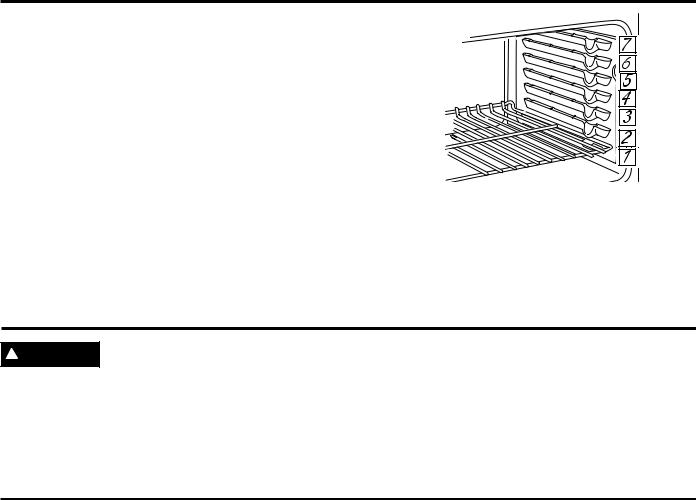
Oven Racks
Recommended rack positions for various types of foods are provided in the Cooking Guide. Adjusting rack position is one way to impact cooking results. For example, if you would prefer darker tops on cakes, muffins, or cookies, try moving food one rack position
higher. If you find foods are too brown on top try moving them down next time.
When baking with multiple pans and on multiple racks, ensure there is at least 1½" between pans to allow sufficient space for air to flow.
Your Oven may have extension racks and/or traditional |
The number of rack positions may vary by model. |
flat racks. |
|
To avoid possible burns, place the racks in the desired |
|
position before you turn the oven on. |
|
Aluminum Foil and Oven Liners

 CAUTION Do not use any type of foil or oven liner to cover the oven bottom. These items can trap heat or melt, resulting in damage to the product and risk of shock, smoke or fire. Damage from improper use of these items is not covered by the product warranty.
CAUTION Do not use any type of foil or oven liner to cover the oven bottom. These items can trap heat or melt, resulting in damage to the product and risk of shock, smoke or fire. Damage from improper use of these items is not covered by the product warranty.
Foil may be used to catch spills by placing a sheet on a lower rack, several inches below the food. Do not use more foil than necessary and never entirely cover an oven rack with aluminum foil. Keep foil at least 1-1/2” from oven walls to prevent poor heat circulation.
Oven Cookware
Cookware Guidelines
The material, finish, and size of cookware affect baking performance.
Dark, coated and dull pans absorb heat more readily than light, shiny pans. Pans that absorb heat more readily can result in a browner, crisper, and thicker crust. If using dark and coated cookware check food earlier than minimum cook time. If undesirable results are obtained with this type of cookware consider reducing oven temperature by 25º F next time.
Shiny pans can produce more evenly cooked baked goods such as cakes and cookies.
Glass and ceramic pans heat slowly but retain heat well. These types of pans work well for dishes such as pies and custards.
Air insulated pans heat slowly and can reduce bottom browning.
Keep cookware clean to promote even heating.
Stoneware heats slowly and retains heat well. It is recommended to preheat this type of cookware if possible. Additional cook time may be required.
Cookware used in broil modes and air fry must be broilsafe.
<![endif]>FoilOvenandRacksOvenOVEN:LinersTHE/ USING
<![if ! IE]><![endif]>Aluminum
<![if ! IE]><![endif]>Cookware/
49-2000831 Rev. 0 |
13 |

<![endif]>USING THE RANGE: Cooking Modes
Cooking Modes
Your new oven has a variety of cooking modes to help you get the best results. These modes are described below. Refer to the Cooking Guide section for rack position and other recommendations for specific modes and foods. Remember, your new oven may perform differently than the oven it is replacing.
Baking and Roasting Modes
Select a mode for baking and roasting based on the type and quantity of food you are preparing. When preparing baked goods such as cakes, cookies, and pastries always preheat the oven first. Follow recipe recommendations for food placement. If no guidelines are provided, center food in the oven.
Traditional Bake
The Bake mode is for baking and roasting. When preparing baked goods such as cakes, cookies, and pastries, always preheat the oven first. To use this mode press the Bake pad, enter a temperature, and then press
Start.
Convection Bake (on some models)
This mode uses air movement from the convection fan to enhance cooking evenness. Your oven is equipped with Auto Recipe Conversion, so it is not necessary to adjust the temperature when using this mode. Always preheat when using this mode. Baking time might be slightly longer for multiple racks than what would be expected for a single rack. To use this mode press the Convection Bake pad, enter a temperature, and then press Start.
Convection Roast (on some models)
The Convection Roast mode is intended for roasting whole cuts of meat on a single rack. This mode uses air movement from the convection fan to improve browning and reduce cooking time. Check food earlier than the recipe suggested time when using this mode. To use this mode press the Convection Roast pad, enter a temperature, and then press Start.
Broiling Modes
Always broil with the oven door closed. Monitor food closely while broiling. Use caution when broiling; placing food closer to the broil element increases smoking, spattering, and the possibility of fats igniting. It is not necessary to preheat when using the Broil modes.
Broil Hi
The Broil Hi mode uses intense heat from the upper element to sear foods. Use Broil Hi for thinner cuts of meat and/or when you would like to have a seared surface and rare interior. To use this mode press the Broil pad once and then press Start.
Broil Lo
The Broil Lo mode uses less intense heat from the upper element to cook food thoroughly while also browning
the surface. Use Broil Lo for thicker cuts of meat and/or foods that you would like cooked all the way through. To use this mode press the Broil pad twice and then press
Start.
Warm
Warm modes are designed to keep hot, cooked foods hot. Cover foods that should remain moist and do not cover foods that should be crisp. Preheating is not required. Do not use warm to heat cold food. It is
recommended that food not be kept warm for more than 2 hours. To use this mode, press the Warm pad then press Start. The control display will show the oven is set to Bake at 170F.
Air Fry (on some models)
Air Fry is a special, no-preheat, cooking mode that is designed to produce foods with a crispier exterior than traditional oven cooking. The Air Fry mode is intended for single rack cooking only. Select Air Fry, then input the desired set temperature and press Start. The temperature can be set between 300°F and 500°F. Preheating is not recommended for this mode. Follow traditional oven recipe or package guidelines for set temperatures and cook times; adjust cook time to achieve your desired crispness. Additional guidelines for using this mode can be found in the Cooking Guide.
14 |
49-2000831 Rev. 0 |
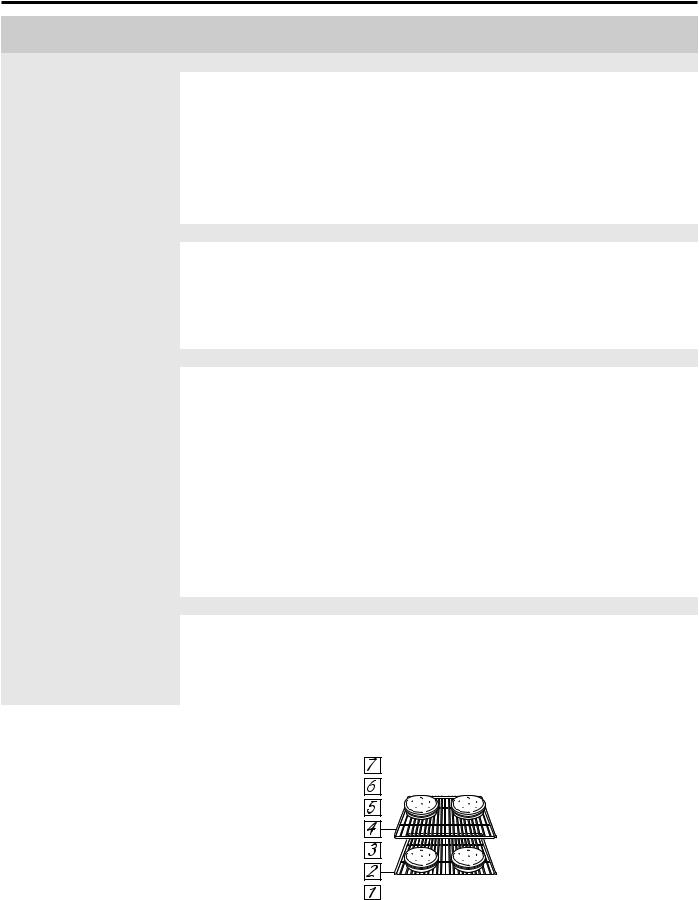
Cooking Guide
|
RECOMMENDED |
RECOMMENDED |
|
|
FOOD TYPE |
MODE(S) |
RACK POSITION(S) |
ADDITIONAL SUGGESTIONS |
|
Baked Goods |
|
|
|
|
|
|
|
|
|
Layer Cakes, sheet cakes, bundt |
|
|
|
|
cakes, muffins, quick breads on a |
Bake |
3 |
Use shiny cookware. |
|
Single Rack |
|
|
|
|
Layer cakes* on Multiple Racks |
Bake |
2 and 4 |
Use shiny cookware. Ensure adequate airflow |
|
Convection Bake |
(see illustration below). |
|||
|
|
|||
Chiffon cakes (angel food) |
Bake |
1 |
Use shiny cookware. |
|
|
|
|
|
|
Cookies, biscuits, scones on a Single |
Bake |
4 |
Use shiny cookware. |
|
Rack |
||||
|
|
|
||
Cookies, biscuits, scones on Multiple |
Bake |
2 and 4 |
Use shiny cookware. For foods like sugar cookies, switch |
|
food location partially through cooking for more even |
||||
Racks |
Convection Bake |
2, 4 and 6 |
||
cooking results between racks. Ensure adequate airflow. |
||||
|
|
|
||
|
|
|
|
|
Beef & Pork |
|
|
|
|
|
|
|
|
|
|
|
|
Use a broil pan; move food down for more doneness/ |
|
Hamburgers |
Broil Hi |
6 |
less searing. Watch food closely when broiling. For best |
|
|
|
|
performance center food below the broil heater. |
|
|
|
|
Use a broil pan; move food down for more doneness/ |
|
Steaks & Chops |
Broil Hi |
6 |
less searing. Watch food closely when broiling. For best |
|
|
|
|
performance center food below the broil heater. |
|
Roasts |
Bake |
2 or 3 |
Use a low sided pan such as a broil pan. |
|
Preheating is not necessary. |
||||
|
|
|
||
Poultry |
|
|
|
|
Whole chicken |
Bake |
2 or 3 |
Use a low sided pan such as a broil pan. |
|
Convection Bake |
Preheating is not necessary. |
|||
|
|
|||
|
|
|
If breaded or coated in sauce avoid Broil Hi modes. Broil |
|
Bone-in chicken breasts, legs, thighs |
Broil Lo |
3 |
skin side down first. Watch food closely when broiling. |
|
Bake |
For best performance when broiling, center food below |
|||
|
|
|||
|
|
|
the broil heater. |
|
|
|
|
|
|
|
|
|
If breaded or coated in sauce avoid Broil Hi modes. Broil |
|
Boneless chicken breasts |
Broil Lo |
2 or 3 |
skin side down first. Watch food closely when broiling. |
|
Bake |
For best performance when broiling, center food below |
|||
|
|
|||
|
|
|
the broil heater. |
|
|
|
|
|
|
Whole turkey |
Bake |
1 |
Use a low sided pan such as a broil pan. |
|
Convection Bake |
1 or 2 |
Preheating is not necessary. |
||
|
||||
Turkey Breast |
Bake |
3 |
Use a low sided pan such as a broil pan. |
|
Convection Bake |
2 or 3 |
Preheating is not necessary. |
||
|
||||
Fish |
Broil Lo |
6 (1/2 thick or less) |
Watch food closely when broiling. For best performance |
|
5 (>1/2 inch) |
center food below the broil heater. |
|||
|
|
|||
Casseroles |
Bake |
3 |
|
|
|
|
|
|
|
Frozen Convenience Foods |
|
|
|
|
|
|
|
|
|
|
|
|
Place food in oven prior to starting mode. Use dark |
|
Single Rack |
Bake |
4 |
cookware for more browning/crisping; use shiny |
|
|
|
|
cookware for less browning. |
|
|
|
|
Use dark cookware for more browning/crisping; use |
|
Multiple Racks |
Convection Bake |
2 and 4 |
shiny cookware for less browning. For multiple racks of |
|
pizzas, stagger left to right, do not place directly over |
||||
|
|
|
||
|
|
|
each other. |
|
|
|
|
|
*When baking four cake layers at a time with traditional bake, use racks 2 and 4.
*When baking four cake layers at a time with convection bake, use racks 2 and 4.
Cook food thoroughly to help protect against food borne illness. Minimum safe food temperature recommendations for food safety can be found at IsItDoneYet.gov. Make sure to use a food thermometer to take food temperatures.
<![endif]>Guide Cooking RANGE: THE USING
49-2000831 Rev. 0 |
15 |
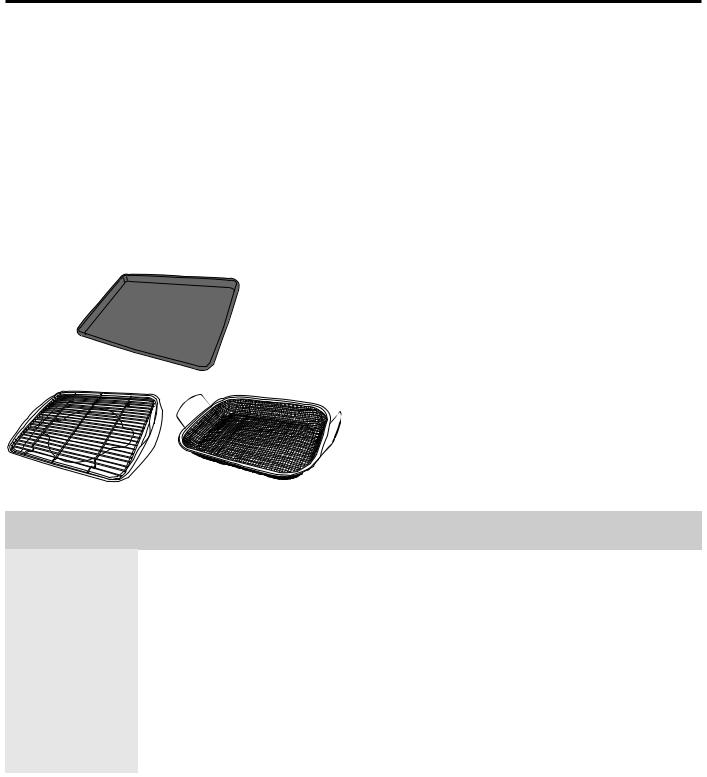
<![endif]>USING THE RANGE: Cooking Guide
Oven Cooking Guide (on some models)
Air Fry Cooking Guide
Air Fry is a special, no-preheat, cooking mode that is designed to produce foods with a crispier exterior than traditional oven cooking. Select Air Fry, then
input the desired set temperature and press Start. The temperature can be set between 300°F and 500°F.
Air Fry Cookware Guidelines
•Only use broil safe cookware when using Air Fry mode.
•A dark sheet pan is recommended. A dark pan promotes better browning and crisping.
•Oven baking baskets and baking grids can also be used. A sheet pan should be placed on the rack below the foods to catch any drippings when using a baking basket.
Primary recommended cookware
General Tips for Air Fry Mode
•The Air Fry mode is designed for cooking on a single rack.
•The Air Fry mode is designed to be used without preheating.
•Rack position 4 is recommended for most foods. Use rack position 3 for thicker foods.
•Foods may cook faster than expected if the oven is already hot when food is placed in the oven.
•When air frying foods with sauce, it is recommended to apply the sauce at the end of cooking.
•If foods are browning too quickly, try a lower rack position or lower oven set temperature.
•For packaged foods, use traditional oven cooking instructions for set temperature and expected cook time.
•It is not necessary to flip or stir food during cooking
•Arrange food in a single layer on the pan, do not overload the pan.
•Always check internal food temperature to confirm minimum safe temperatures have been reached. Minimum safe food temperatures can be found on packages and at IsItDoneYet.gov.
Alternate cookware options |
|
|
|
|
|
|
|
RECOMMENDED |
|
RECOMMENDED |
|
RECOMMENDED |
|
|
|
|
|
|||
FOOD TYPE |
RACK POSITION(S) |
|
SET TEMPERATURES (F°) |
|
COOK TIME (MIN) |
NOTES |
Fresh boneless fish or |
|
|
|
|
|
User lower set temperatures for larger pieces. |
poultry pieces, breaded such |
4 |
|
375-400 |
|
15-30 |
|
|
|
Use shiny cookware. |
||||
as nuggets, tenders, fillets |
|
|
|
|
|
|
|
|
|
|
|
|
|
|
|
|
|
|
|
|
Fresh bone in |
4 |
|
375-400 |
|
25-40 |
Salt wings or coat in a dry rub, if using sauce |
chicken wings |
|
|
apply after cooking or toward the end of cooking |
|||
|
|
|
|
|
||
|
|
|
|
|
|
|
Fresh bone in chicken |
3 or 4 |
|
375-400 |
|
30-55 |
User lower set temperatures for larger pieces. |
drumsticks or thighs |
|
|
||||
|
|
|
|
|
|
|
|
|
|
|
|
|
|
|
|
|
|
|
|
Parchment paper is recommended when |
Fresh French fries, |
4 |
|
400-425 |
|
15-30 |
preparing fresh French fries. For crispier fries, |
thin (< ½ inch) |
|
|
toss fries in corn starch or rice flour before |
|||
|
|
|
|
|
||
|
|
|
|
|
|
cooking. |
|
|
|
|
|
|
|
|
|
|
|
|
|
Parchment paper is recommended when |
Fresh French fries, |
3 or 4 |
|
375-400 |
|
20-35 |
preparing fresh French fries. For crispier fries, |
thick (> ½ inch) |
|
|
toss fries in corn starch or rice flour before |
|||
|
|
|
|
|
||
|
|
|
|
|
|
cooking. |
|
|
|
|
|
|
|
Frozen packaged |
3 or 4 |
|
Use traditional oven(not Air Fry) cooking instructions as a guideline for set temperature and cook time. Additional |
|||
(use rack position 3 for |
|
cook time beyond recommended package time may be required for some foods. If oven is hot when starting, food |
||||
foods |
|
|||||
thicker foods) |
|
may cook faster than the minimum package time. |
||||
|
|
|||||
|
|
|
|
|
|
|
16 |
49-2000831 Rev. 0 |
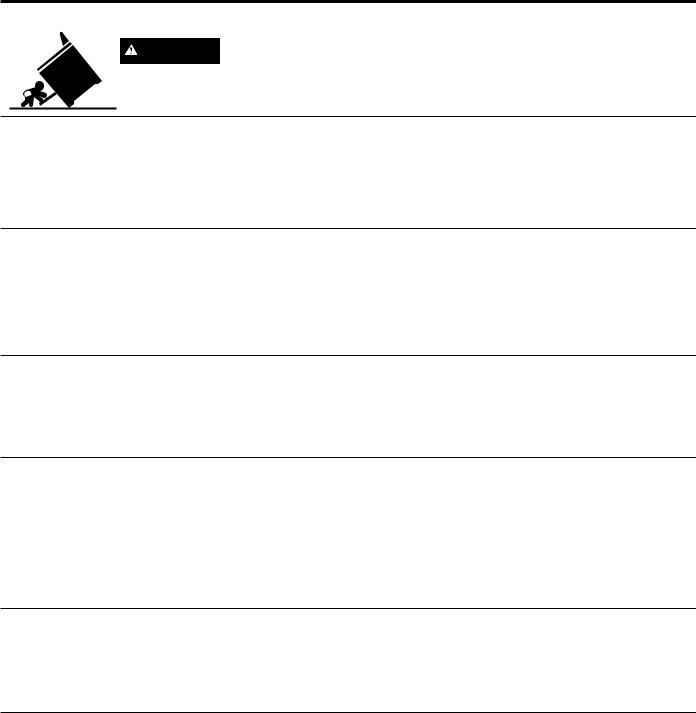
Cleaning the Range – Exterior
Be sure all controls are off and all surfaces are cool before cleaning any part of the range.
WARNING If your range is removed for cleaning, servicing or any reason, be sure the anti-tip device is reengaged properly when the range is replaced. Failure to
take this precaution could result in tipping of the range and can result in death or serious burns to children or adults.
Control Knobs
The control knobs may be removed for easier cleaning. |
also be washed with soap and water. Make sure the |
Make sure the knobs are in the OFF positions and pull |
inside of the knobs are dry before replacing. |
them straight off the stems for cleaning. |
Replace the knobs, in the OFF position to ensure proper |
|
|
The knobs can be cleaned in a dishwasher or they may |
placement. |
Control Lockout
If desired, the touch pads may be deactivated before cleaning.
See Lock Controls in the Oven Controls section in this manual.
Clean up splatters with a damp cloth.
Remove heavier soil with warm, soapy water. Do not use abrasives of any kind.
Reactivate the touch pads after cleaning.
Control Panel
It’s a good idea to wipe the control panel after each use. |
Do not use abrasive cleansers, strong liquid cleansers, |
Clean with mild soap and water or vinegar and water, |
plastic scouring pads or oven cleaners on the control |
rinse with clean water and polish dry with a soft cloth. |
panel - they will damage the finish, including Black |
|
Stainless Steel. |
Oven Exterior
Do not use oven cleaners, abrasive cleansers, strong liquid cleansers, steel wool, plastic scouring pads, or cleaning powders on the interior or exterior of the oven. Clean with a mild soap and water or vinegar and water solution. Rinse with clean water and dry with a soft cloth. When cleaning surfaces, make sure that they are at room temperature and not in direct sunlight.
If stain on the door vent trim is persistent, use a mild abrasive cleaner and a sponge-scrubber for best results.
Spillage of marinades, fruit juices, tomato sauces and basting liquids containing acids may cause discoloration and should be wiped up immediately. Let hot surfaces cool, then clean and rinse.
Painted Surfaces and Black Stainless Steel
Painted surfaces include the sides of the range and the |
Do not use commercial oven cleaners, cleaning |
door, top of control panel, maintop trims and the drawer |
powders, steel wool or harsh abrasives on any painted |
front. Clean these with soap and water or a vinegar and |
surface, including Black Stainless Steel. |
water solution. |
|
Stainless Steel - Excluding Black Stainless Steel (on some models)
Do not use a steel wool pad; it will scratch the surface. |
To inquire about purchasing cleaning products including |
|
To clean the stainless steel surface, use warm sudsy |
stainless steel appliance cleaner or polish, see the |
|
Accessories and Consumer Support sections at the end |
||
water or a stainless steel cleaner or polish. Always wipe |
||
of this manual. |
||
the surface in the direction of the grain. Follow the cleaner |
||
|
||
instructions for cleaning the stainless steel surface. |
|
<![endif]>Exterior – Range the Cleaning CLEANING: AND CARE
49-2000831 Rev. 0 |
17 |
